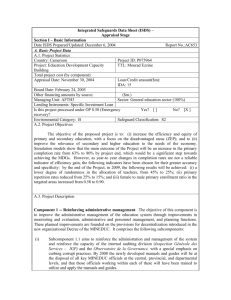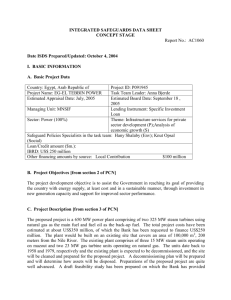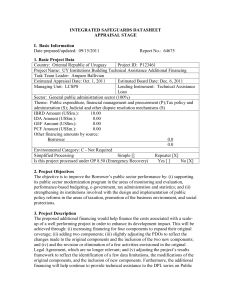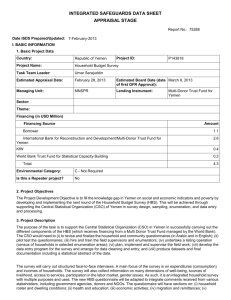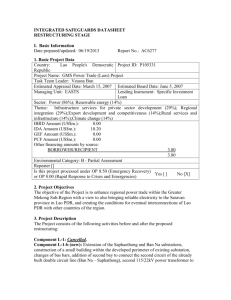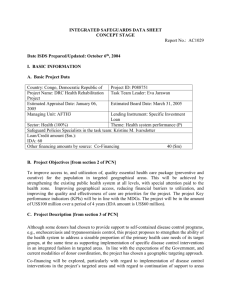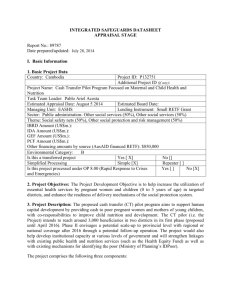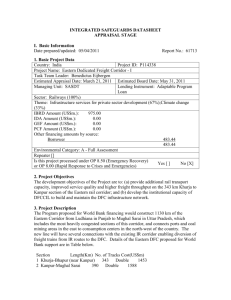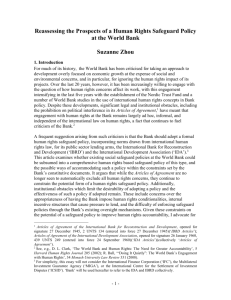integrated safeguards datasheet - Documents & Reports
advertisement
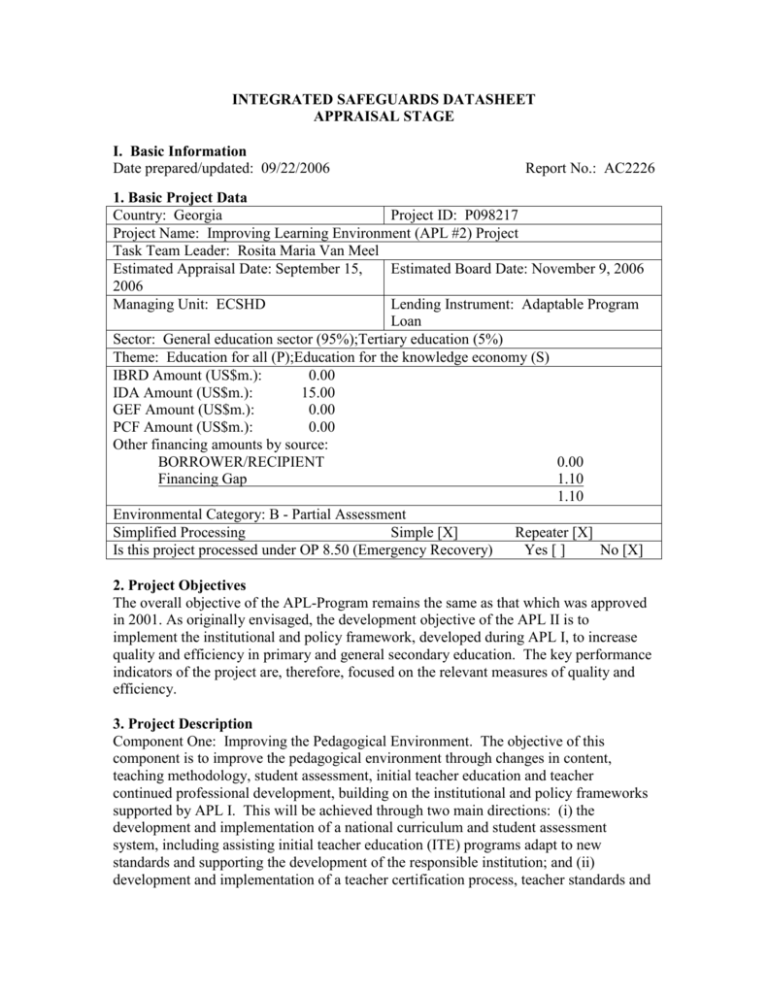
INTEGRATED SAFEGUARDS DATASHEET APPRAISAL STAGE I. Basic Information Date prepared/updated: 09/22/2006 Report No.: AC2226 1. Basic Project Data Country: Georgia Project ID: P098217 Project Name: Improving Learning Environment (APL #2) Project Task Team Leader: Rosita Maria Van Meel Estimated Appraisal Date: September 15, Estimated Board Date: November 9, 2006 2006 Managing Unit: ECSHD Lending Instrument: Adaptable Program Loan Sector: General education sector (95%);Tertiary education (5%) Theme: Education for all (P);Education for the knowledge economy (S) IBRD Amount (US$m.): 0.00 IDA Amount (US$m.): 15.00 GEF Amount (US$m.): 0.00 PCF Amount (US$m.): 0.00 Other financing amounts by source: BORROWER/RECIPIENT 0.00 Financing Gap 1.10 1.10 Environmental Category: B - Partial Assessment Simplified Processing Simple [X] Repeater [X] Is this project processed under OP 8.50 (Emergency Recovery) Yes [ ] No [X] 2. Project Objectives The overall objective of the APL-Program remains the same as that which was approved in 2001. As originally envisaged, the development objective of the APL II is to implement the institutional and policy framework, developed during APL I, to increase quality and efficiency in primary and general secondary education. The key performance indicators of the project are, therefore, focused on the relevant measures of quality and efficiency. 3. Project Description Component One: Improving the Pedagogical Environment. The objective of this component is to improve the pedagogical environment through changes in content, teaching methodology, student assessment, initial teacher education and teacher continued professional development, building on the institutional and policy frameworks supported by APL I. This will be achieved through two main directions: (i) the development and implementation of a national curriculum and student assessment system, including assisting initial teacher education (ITE) programs adapt to new standards and supporting the development of the responsible institution; and (ii) development and implementation of a teacher certification process, teacher standards and accreditation system for ITE and continuing professional development (CPD) programs, including the development of the responsible institution. The first phase of the APL supported the development of the curriculum framework, initial piloting and implementation of the curriculum in three grades, a system of student examination, and in-service teacher development. During APL I, the Ministry of Education and Science (MoES) established a National Curriculum and Assessment Center (NCAC) and a Teacher Professional Development Center (TPDC). APL II will build on these successes, but is necessary to further build the capacity of these nascent institutions and all of the people involved in developing or implementing the reforms. The specific objectives and activities of the two related subcomponents are discussed below. Subcomponent 1A: National Curriculum and Student Assessment System Development. The objective of this subcomponent is to improve the teaching content and methodologies in line with the national curriculum framework; to establish a system of student assessment so as to identify difficulties in student learning and develop targeted programs accordingly; and to assist ITE institutions adapt their programs to take into account the changes in teaching standards, the national curriculum, and student assessment methodologies. The National Curriculum and Assessment Center (NCAC) that is responsible for implementing these policies was established in spring 2006. This subcomponent would develop the capacity of the NCAC in terms of the managerial and technical capacity of the staff; support the development, piloting and implementation of the national curriculum in almost all grades and subjects which will include the training of teacher trainers, the training of teachers, and other dissemination activities; support the development of a system of student formative assessment; and conduct sample based 4th grade student assessments in Georgian Language and Literature and in Mathematics. The NCAC will also be responsible to support the reform of the ITE system and institutions. The Center will strengthen the technical capacity of higher education institutions involved in ITE through the provision of technical and materials to reform the ITE programs to meet the new standards for teacher certification and reflect the curriculum and student assessment reforms. For these purposes, the Project (including financing from the Government, Credit and Grant) would finance technical assistance; training; publication and dissemination; workshops and conferences; the acquisition of copyrights and translation, editing and printing of materials for a library in education science; a limited amount of goods and works for establishing the Center; and the operations of the Curriculum and Assessment Center. The MoES would be responsible for the policy decisions and overall monitoring and evaluation of the sector; and the NCAC would be responsible for the implementation of the program. It would finance the MoES policy unit to elaborate a strategy to address the challenges of the tertiary education system in a financially sustainable manner as part of the policy dialogue with the government on improving the efficiency and equity of the overall system and provide resources to improve governance structures and move to a credit course system A radical new higher education law has recently been passed, and reforms are starting but could benefit from analysis and broader consultation. Subcomponent 1B: Professional Development of Teachers. The objective of this subcomponent is to improve the qualifications of teachers through the development and implementation of a teacher professional development system. The educational institution responsible for building the professional development system of teachers was also established in 2006. This subcomponent would develop the capacity of the Teachers Professional Development Center (TPDC) in terms of the managerial and technical capacity of the staff; develop standards for teachers including the dissemination of materials and holding of workshops and conferences; develop and conduct certification of both the existing and new teaching force; develop accreditation mechanisms for both ITE and CPD programs; and establish a registration system of teacher, teacher-candidate, and training programs. For these purposes, the Project (including financing from the Government, Credit and Grant) would finance technical assistance; training; publication and dissemination of materials; a limited amount of goods and works; and the operations of the TPDC. The MoES would be responsible for the policy decisions and overall monitoring and evaluation of the sector; and the TPDC would be responsible for the implementation of the program. Component Two: Improving the Physical Learning Environment. The main objective of this component is to improve the school physical learning environment in targeted schools to complement the investments on improving the quality of the pedagogical learning environment and to demonstrate how the efficiency of the school network could be improved through the adoption of more efficient school building standards and through school consolidations. The main outcome of this component would be that 100% of children currently studying in schools in emergency condition are in safe and comfortable schools. The Bank credit will be used to finance the construction, furnishing and equipping of about eight schools in different parts of the country that will, on average, be a consolidation of two existing schools (target: 8 schools with 4,750 number of student beneficiaries) The Bank-financed program is designed with the understanding that the Government will at the same time be implementing a major capital investment program that will rehabilitate part of the existing school infrastructure to an adequate level (repair of roofing, windows, doors, and ensuring that all heating, electricity, water and sewage systems are operational. To ensure that newly upgraded school infrastructure is maintained, the component will also support the development and adoption of a school maintenance strategy, including the necessary amendment of the General Education Law and adoption of regulations and the development of a school maintenance manual and training in the use of that manual to upgrade the capacity of school boards and managers in this area. 4. Project Location and salient physical characteristics relevant to the safeguard analysis The Bank credit will be used to finance the construction, furnishing and equipping of about eight schools in different parts of the country that will, on average, be a consolidation of two existing schools. The environmental safeguard was addressed due to the possible environmental impact of the school construction.The land upon which the schools will be built already are or will be properties of the schools and do not raise any resettlement issues. Because the new schools will be a consolidation of existing schools, the concerns of the community/parents will be carefully assessed and addressed as part of the project design. 5. Environmental and Social Safeguards Specialists Ms Helen Z. Shahriari (ECSSD) Ms Darejan Kapanadze (ECSSD) 6. Safeguard Policies Triggered Environmental Assessment (OP/BP 4.01) Natural Habitats (OP/BP 4.04) Forests (OP/BP 4.36) Pest Management (OP 4.09) Physical Cultural Resources (OP/BP 4.11) Indigenous Peoples (OP/BP 4.10) Involuntary Resettlement (OP/BP 4.12) Safety of Dams (OP/BP 4.37) Projects on International Waterways (OP/BP 7.50) Projects in Disputed Areas (OP/BP 7.60) Yes X No X X X X X X X X X II. Key Safeguard Policy Issues and Their Management A. Summary of Key Safeguard Issues 1. Describe any safeguard issues and impacts associated with the proposed project. Identify and describe any potential large scale, significant and/or irreversible impacts: The Credit will be used to finance the construction of 8 schools, all of them will replace schools in emergency status or schools operating in non-educationally appropriate circumstances. The construction of the schools will trigger the environmental safeguard, because of the noise and other inconveniences associated with the construction, need to appropriately dispose of construction waste, use appropriate construction material and arrange for proper water and sanitation in the school. The school land already is the property of the school or will be provided by the local authorities. There are no land acquisition issues. There are no settlements on the land and, therefore, the involuntary resettlement safeguard is not triggered. No large scale, significant or irreversible impacts are anticipated. 2. Describe any potential indirect and/or long term impacts due to anticipated future activities in the project area: The future activities in the project areas will be the use of the school for education of children. The long-term impacts of this use will be taken into consideration in the design of the school and particularly in the appropriate water and sanitation measures. 3. Describe any project alternatives (if relevant) considered to help avoid or minimize adverse impacts. The only relevant project alternative which was considered was a school rehabilitation rather than school construction project (as discussed at the Safeguards meeting following the Project concept review meeting). This alternative project design had much of the same environmental concerns as the current project design. As part of the 'feasibility studies' planned for each school construction site, we will ensure that no additional issues arise, (i.e. no need for land acquisition and no resettlement issues). Because the Project design now includes school consolidation, the feasibility study will also include a particular social component to assess and address any community/parents concern regarding the planned consolidation. 4. Describe measures taken by the borrower to address safeguard policy issues. Provide an assessment of borrower capacity to plan and implement the measures described. The Borrower is undertaking a feasibility study of each school proposal, which includes an assessment of potential environmental impact in order to develop an appropriate plan for mitigation measures. The borrower, supported by the Municipal Development Fund (MDF) (which has recently absorbed the Georgian Social Investment Fund (GSIF)), has completed an assessment and planning for mitigation measures. The environmental management framework (including draft environmental management plan) has been published in Georgia and the framework was discussed with key stakeholders. The MDF and GSIF have experience in complying with the Bank's environmental safeguard policy. 5. Identify the key stakeholders and describe the mechanisms for consultation and disclosure on safeguard policies, with an emphasis on potentially affected people. The key stakeholders are the Ministry of Environmental Protection and Natural Resources, civil society organizations and communities in which the schools will be built. They were informed that the Environmental Management Framework was made available on the MDF website. The meeting with the key stakeholders has been held and its minutes submitted to the Association. The School Boards will have an important role in supervising the construction of the schools, which will include compliance with the EMP. B. Disclosure Requirements Date Environmental Assessment/Audit/Management Plan/Other: Date of receipt by the Bank 09/06/2006 Date of "in-country" disclosure 09/21/2006 Date of submission to InfoShop 09/22/2006 For category A projects, date of distributing the Executive Summary of the EA to the Executive Directors * If the project triggers the Pest Management and/or Physical Cultural Resources, the respective issues are to be addressed and disclosed as part of the Environmental Assessment/Audit/or EMP. If in-country disclosure of any of the above documents is not expected, please explain why: C. Compliance Monitoring Indicators at the Corporate Level (to be filled in when the ISDS is finalized by the project decision meeting) OP/BP/GP 4.01 - Environment Assessment Does the project require a stand-alone EA (including EMP) report? If yes, then did the Regional Environment Unit or Sector Manager (SM) review and approve the EA report? Are the cost and the accountabilities for the EMP incorporated in the credit/loan? The World Bank Policy on Disclosure of Information Have relevant safeguard policies documents been sent to the World Bank's Infoshop? Have relevant documents been disclosed in-country in a public place in a form and language that are understandable and accessible to project-affected groups and local NGOs? All Safeguard Policies Have satisfactory calendar, budget and clear institutional responsibilities been prepared for the implementation of measures related to safeguard policies? Have costs related to safeguard policy measures been included in the project cost? Does the Monitoring and Evaluation system of the project include the monitoring of safeguard impacts and measures related to safeguard policies? Have satisfactory implementation arrangements been agreed with the borrower and the same been adequately reflected in the project legal documents? Yes Yes Yes Yes Yes Yes Yes Yes Yes D. Approvals Signed and submitted by: Task Team Leader: Environmental Specialist: Social Development Specialist Additional Environmental and/or Social Development Specialist(s): Name Ms Rosita Maria Van Meel Ms Darejan Kapanadze Ms Helen Z. Shahriari Date 09/20/2006 09/19/2006 07/12/2006 Approved by: Regional Safeguards Coordinator: Mr Juergen Voegele Comments: Sector Manager: Mr Armin H. Fidler Comments: No additional comments at this time. 09/22/2006

